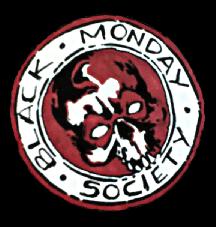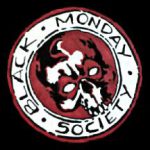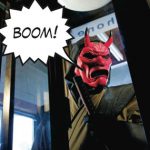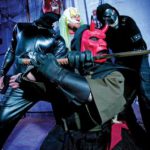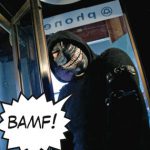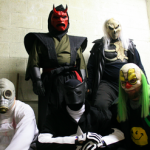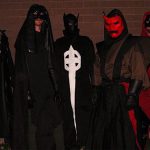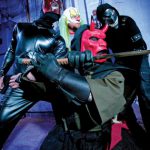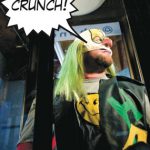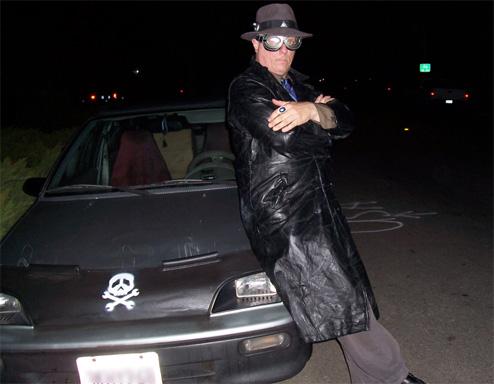 By Paul Constant
By Paul Constant
They hide their true identities behind elaborate masks and costumes, patrolling the streets of downtown Salt Lake City in groups of two and three. People react to them in various ways: Older folks tend to ignore them. Drunken young adults want to pose with them for photos. Teenagers tend to hiss, growl and shout in their general direction, while children walk right up to them and ask what they are doing. Despite the masks and secret identities, they’re completely open about their purpose.
“Inferno,” one of the newest members of the group, is unfazed by the evening chill. He passes by a group of teens. One of them shouts: “Halloween’s not over!” Inferno winces, rolls his eyes, and responds, in the bored tone of someone who’s tired of hearing the same joke over and over again, “Nope, it’s not.” A girl of about 14 breaks from the mass of tittering boys and bravely approaches Inferno. He’s wearing a red hood and tunic, thigh-high pleather boots, and a matching black pleather mask that covers his eyes and nose. She breaks the awkward silence: “Can I ask about your costume?”
Inferno nods, unconsciously touches his red goatee and answers: “I’m part of the Black Monday Society.”
The girl cocks her head. “The Black Monday Society?”
“Yeah,” Inferno begins, a little more comfortable now, getting into a well-worn groove, “We just walk around, you know, patrol the streets.”
“Like Citizens on Patrol?” adds the girl, invoking the title of the fourth Police Academy movie. Her friends seem to get the reference and break into laughter.
Inferno brightens. “Yeah. “Citizens on patrol.”
“Cool!” says the girl, and despite the fact that her male friends are still hanging back—way back—and giggling, she seems to be genuinely happy about the idea. Inferno smiles and hands her a business card.
“We have a Website,” he says. “Look us up, it’ll tell you more about what we do. That’s pretty much what it’s about. It’s a lot of fun.”
“OK,” she says, waving goodbye with the card and running back to her friends, “Have fun!”
“You, too,” Inferno says. “Bye.”
And then he goes back to patrolling the streets, keeping his eye out for danger, wherever it lurks.
We Need Another Hero
The Black Monday Society started five years ago, when a Salt Lake City-area tattoo artist and lifelong comic-book fan named Dave went exploring on MySpace. “I always told my wife, even before we got married, that if I ever see a real superhero, I’m so going to be one,” he says. “Come on, just the idea of wearing a mask, going out, doing something good? Being somebody else for a little bit? Doesn’t that sound a little enthralling to you?”
After doing a search for comic-book-related fan groups, Dave happened upon the Web pages of two Indianapolis men who go by the names “Mr. Silent” and “Doktor DiscorD.” They called themselves Real Life Superheroes, and they went on patrol on the Indianapolis streets searching for wrongs to right.
“So,” Dave says, “I set up a MySpace page, made an identity for myself, just to talk to them, and it kind of evolved from there. It was really inspiring.”
Dave couldn’t believe this was happening, that his childhood obsession was taking shape, and that people all over the world were a part of it. “I went home to my wife and told her about it and she said, ‘Wow,’ and then she said, ‘Is this for real?’ and I said, ‘Yeah,’ and she said, ‘So, when do you go out?’ and I said, ‘As soon as possible.’”
Like all Real Life Superheroes, Dave, 37, uses only his first name, and he’d rather go by his character’s name anyway. His first superhero identity was “The American Corpse.” He dressed in an Israeli army gas mask, fedora and a suit and tie, much like classic DC Comics superhero The Sandman. Dave’s good friend, a very tall man with a lazy Johnny Cash drawl, says he’s “always been fascinated by ghosts and goblins and demons and things of that nature,” so he decided to call himself “Ghost.” He made a costume of a rubber Halloween skeleton mask adorned with a shock of white hair and a matching ribcage on his chest. Ghost is 32 and works in real life as a concrete finisher. Quiet and unassuming, he explains his unusual hobby by saying, “It’s every little boy’s fantasy to be a real life superhero.”
Ghost sums up his passion for the street with a comment on his blog: “Doesn’t matter how many people snicker at us. What matters is we are out there doin’ our duty for justice.”
Recounting their first night out on patrol in 2001, American Corpse and Ghost say they were standing by their car on a city street having a smoke. A Salt Lake City cop on patrol approached them and pulled over. American Corpse says he decided to slowly approach her to explain their costumes and superheroic intent. She firmly told them, “Please stand by the hood of the car.” American Corpse kept walking toward the officer, then reached into his jacket to pull out his wallet and identification. Reacting to Corpse’s decision to keep moving, the officer put her hand on her revolver and shouted, “Stand by the hood of the car, now!” American Corpse says he wasn’t even really thinking but decided to try and calm the situation by saying, “It’s OK, ma’am, don’t worry. Relax; I’m a superhero.”
The cop eventually let them move on, but the heroes claim the Black Monday Society is on the Salt Lake City Police Department’s official list of street gangs. A spokesman for the SLCPD would not confirm that statement.
When Flats Need Fixing
If a healthy number of Websites and blogs are any indication, there are hundreds of Real Life Superheroes around the world, mainly operating out of urban areas. One of the best known is “Citizen Prime,” an RLS from Phoenix. Prime is a husband, father and office worker who puts on a costume (or uniform, as the RLS community prefers) with intent to fight crime. Though Prime does carry a pair of intriguingly named “stun-knuckles” in case he has to protect himself or others, most of the work he does fits neatly within the category of good Samaritanism—flat-tire repair and making speeches to elementary-school students about the dangers of drug use. But in the past year, buoyed by increased media attention, Prime has also started a successful toy drive to help needy children.
Prime, an office worker in his 40s, has a certain charisma, the kind usually seen in community organizers and old-fashioned politicians. In conversations, he’s prone to wholesome expressions like, “Oh, my gosh,” and “Gee,” sounding like a real-life Jimmy Stewart. He vouches for the Black Monday Society, implicitly. “They’re really good guys. I’ve had contact with them for a while now, and they seem like the real deal.” Prime visited the Black Monday Society over the long winter, but—human as they were—the heroes decided it was too cold to patrol. Still, one hero wrote on his blog that “we did suit up and take some photos,” and that “more team-ups will happen when it gets a little warmer.”
New Real Life Superheroes seem to appear every day. They add their photos and biographies to Websites like RealLifeSuperheroes.com and share their thoughts on weaponry, good deeds and other topics on blogs such as Heroes Network. There’s the Justice Society of Justice, based in Indianapolis; The Boise Brigade, and, from Washington, D.C., the Capitol City Super Squad. “Zetaman” patrols the streets of Portland, Ore., wearing a utility belt loaded with a first-aid kit, a baton and a Taser, among other gadgets.
Polarman shovels the snow-covered sidewalks of Iqalulit, the capital city of Canada’s youngest province, Nunavut—located north of Quebec on Baffin Island. Entomo the Insect Man claims to protect Naples, Italy, and frequents superhero message boards with hilariously Roberto Benigni-esque broken English comments. His MySpace page boasts a mission statement: “To be a Real Life Superhero is truly the greatest deed a man can accomplish in a backwards world like this, where fiction is truer to reality than reality itself. On the other hand, the chance to fight for such a stunning planet is too significant to be turned down. Hear my buzz, fear my bite,” and it ends, as all his posts do, with his tagline: “I inject justice!”
Whole businesses have sprung up around the RLS life. Hero-Gear.net deals in costumes for Real Life Superheroes. Armories that produce chain mail and weapons for Renaissance fair actors have started to sell to the RLS community, as well. Dressing up like a superhero and going on patrol seems to be looking less like a bizarre pastime than it does a lifestyle choice, according to some of the heroes. Think teenagers going goth or animal-rights activists fervently volunteering for PETA.
The media is giddily spreading the word about RLS. Some television stations have struck a gold mine in covering regional “superteams,” packing their reports with references to Batmobiles and “Pow! Bang! Boom!” sound effects. A reporter from Rolling Stone went on patrol with the Black Monday Society last fall (though the magazine has yet to publish the story) and several filmmakers are rushing to finish documentaries about the Real Life Superhero movement. Members of The Black Monday Society claim one documentary maker told them that, to be featured in his film, they’d have to sign the rights to their superhero identities away to him. They declined. Another filmmaker and his subjects hosted a Times Square publicity stunt covered in The New York Times last October. Your Friendly Neighborhood Superhero, a recently completed documentary, is scheduled for various film festivals this spring. See RealLifeSuperhero.com for a snippet of the film.
Internet reaction to the RLS movement is mixed. RLS and superhero fans are continuously posting words of encouragement on each other’s blogs. But, as soon as a non-RLS site notices them, the general public, hidden securely behind a guise of anonymity, tears them to shreds. After a story about Silent and DiscorD appeared on comic-book writer Warren Ellis’s blog, the posters unanimously decided that RLSs were endangering themselves, if not others. One commenter, Monk Eastman, summed up the feelings this way: “I predict the following headline: ‘Oddly Dressed Virgin Found Shot 1,123 Times.’”
“A Little Gimmicky?”
Dave quickly dropped the American Corpse persona for another identity: a tights-wearing street fighter named Ferox. Ferox is reserved for Dave’s patrols farther north in Ogden. When in Salt Lake City, Dave is Insignis, a robed figure with a giant white cross across his chest. “The most easily recognizable symbol in the world is the cross,” he explains, “So what better symbol to have?” (The two names are derived from a large tattoo across his back that reads “Insignis Ferox,” Latin for “Mark of the Wild One.”)
After those first few patrols with Ghost, Insignis’ friends were quick to join them. The team grew to 13 members strong in a matter of months. The group originally patrolled on Mondays—hence the name—but “things are much more likely to happen on Fridays and Saturdays, so the Monday thing didn’t last long,” Insignis says. They stuck with the name primarily because “it sounds cool.”
New identities are common with the Black Monday Society: Inferno took his name because of a fiery temper he admits used to get him in trouble before becoming a RLS. But the 33-year-old recently decided to focus on his sense of humor by becoming “Ha!,” a clown-themed superhero.
Oni, 36, based his identity on a Japanese demon. He’s married to a woman the team calls “Mother One.” She creates most of their costumes by hand. “She’s very supportive of this,” Oni says. Most of the team, including 38-year-old occasional member “Silver Dragon,” a thin man with a thick Southern accent, are married. They say their wives are proud of them but balked at a reporter’s request to speak with the women. Earlier this year, Oni went on his first patrol with his daughter, who will take the name “Frost” as soon as she has a costume. “I was very nervous and excited at the same time;” he wrote on his blog. “I hoped that nothing would happen on her first time out. I am proud that she wants to give back to the community and help people that need it.”
The heroes say they have been spending more time in Ogden lately because of what they perceive as increased gang activity. Ogden Mayor Matthew Godfrey takes issue with that claim: “We have had a seven-year decline of crime in Ogden and one of the keys to that is getting the community involved. Having neighbors be vigilant and engaged is a critical ingredient to safer neighborhoods.” Godfrey adds that the Black Monday Society “fits in” with this push for community involvement. Although he finds them “a little gimmicky,” Godfrey allows that, “We will take their participation any way we can get it.” The Salt Lake City Police Department had no comment on the Black Monday Society. Lt. Paul Jaroscak, spokesman for the Salt Lake County Sheriff’s Department, says he has “no knowledge or comment” regarding the group.
If the local cops are sketchy on their knowledge of the superheroes, it might be due to the group’s lack of clarity. What, exactly, does the Black Monday Society do? They talk about “helping people” and “helping the homeless.” But, on one evening this past November, the patrol’s big events included a photo session with a gaggle of drunken college students, some heckling from passersby and a thumbs-up from an enthusiastic tourist from Minneapolis, who wished there was something like this “back home.” The patrol also handed out a couple of dollars to a homeless man with the telltale facial scabs of heavy meth use.
The team contends the patrols are its work, and that members curb crime simply by being seen. And Silver Dragon says there’s proof: “I’ve heard from friends that, after we patrol a particular neighborhood, there’s no crime there for the rest of the night.” That November patrol was one of the last crime-fighting excursions of 2007. The team has laid low for the winter, declaring Salt Lake City’s long, harsh winter too cold to patrol. But they plan on taking to the streets again, now that spring has arrived.
Oni, the only member of the Black Monday Society with extensive martial-arts training, recalls one time when he confronted a drug-addled man who was abusing his mother in a city park. “The first thing we do is call the cops,” he says, “in any situation.” Most superheroes will, in fact, say the same thing. They strongly advise against getting directly involved in police calls.
After calling 911, Oni and Ghost approached the man. They say he promptly relented when confronted with men dressed as demons. Insignis also recalls a time they chased after a drunk man who was standing by the side of the road, trying to punch passing cars. The man got away, but Insignis says, laughing, “He probably won’t be doing that again anytime soon.”
Outside Salt Lake City, the superhero action is getting a little more feverish and a lot less law abiding. Rumors have spread in the RLS community that one of their own, a man known as “Nostrum,” based in Louisiana, has lost an eye doing battle with a criminal. An RLS from Florida known as “Master Legend” claims to attack evildoers, bashing garbage cans over the heads of crack fiends and kicking others with his steel-toe boots. Another man, known as “Hero,” has quit fighting crime and is taking up ultimate fighting. “There is only one thing I can always count on, one thing that will always be there and that is the fight. The fight is all I have,” he recently blogged.
The Black Monday Society has set up an office, and Oni says they are working to gain legal status as a non-profit organization. “As soon as we do that, it’ll open up a lot more doorways for us so we can start receiving money and we can help more people,” he says, adding that “I’d like to do more than just help the homeless. I’d like to start helping abused and battered women. Things like that.”
In a parking lot after the patrol, the team gathers to smoke cigarettes and share a laugh or two. Inferno refers to Insignis as “Father O’Malley,” and asks him if his sidekick’s name is “Altar Boy.” Insignis laughs it off but then snaps back on message, insisting that the Black Monday Society is seeking more than fun and fame: “Instead of being the guy on the couch saying ‘God, I wish somebody would do something,’ I get to be the guy on the couch who says, ‘Yeah, I did something!’ or, ‘At least I tried.’ No regrets, no nothing. Just pure do.”
http://www.cityweekly.net/utah/article-6056-feature-slc-superheroes-the-black-monday-society-keeps-an-eye-out-for-street-crime-so-you-donrst-have-to.htm
